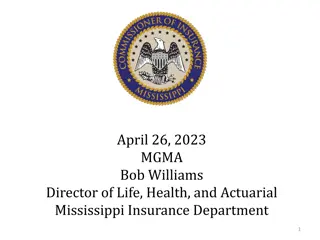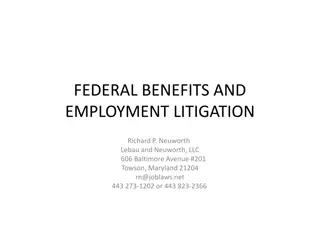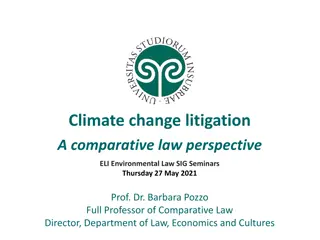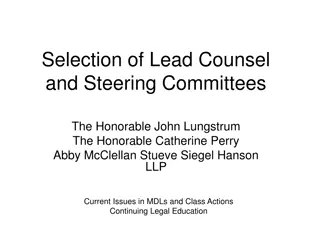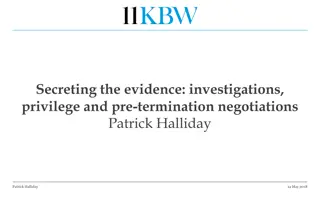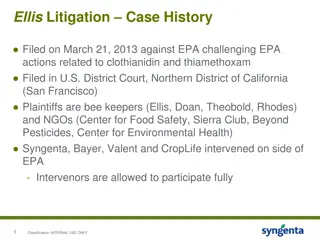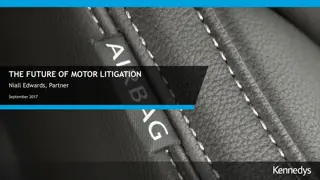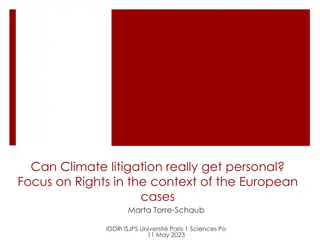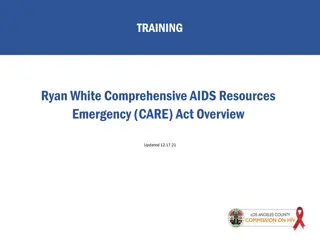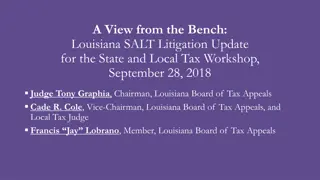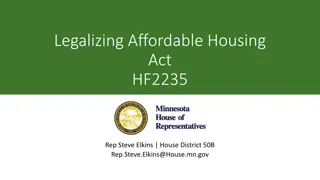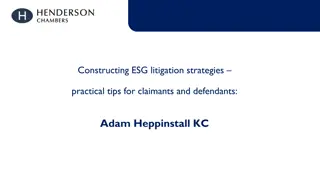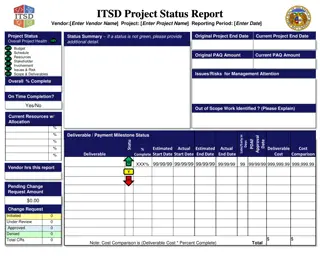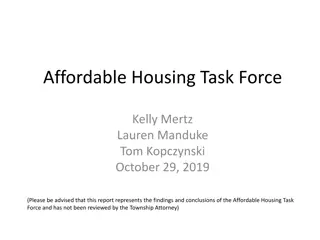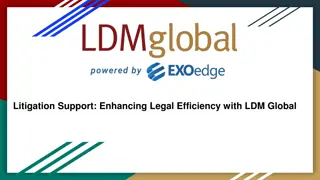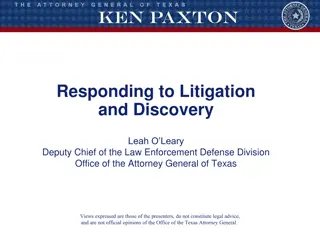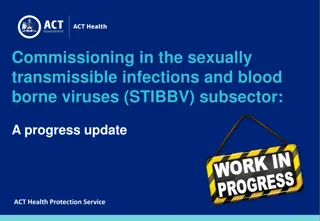Update on Federal Affordable Care Act Litigation Status
A detailed update on the ongoing litigation surrounding the Affordable Care Act, including major pending cases like Texas v. United States, State of New York v. United States Department of Labor, and the Individual Mandate Case. The timeline of events and key legal actions are outlined, providing insights into the complex legal battle surrounding healthcare policy.
Download Presentation

Please find below an Image/Link to download the presentation.
The content on the website is provided AS IS for your information and personal use only. It may not be sold, licensed, or shared on other websites without obtaining consent from the author. Download presentation by click this link. If you encounter any issues during the download, it is possible that the publisher has removed the file from their server.
E N D
Presentation Transcript
A DISPASSIONATE A DISPASSIONATE UPDATE ON UPDATE ON THE STATUS OF FEDERAL THE STATUS OF FEDERAL AFFORDABLE CARE ACT AFFORDABLE CARE ACT LITIGATION LITIGATION Indiana Department of Indiana Department of Insurance Annual Continuing Legal Education Annual Continuing Legal Education Indianapolis, Indiana Indianapolis, Indiana September 24, 2019 September 24, 2019 By By William G. Schiffbauer, Esq. William G. Schiffbauer, Esq. Insurance
Major Pending Litigation Major Pending Litigation I. I. Texas et al v. United States of America et al Texas et al v. United States of America et al, U.S. District Court, Northern District of Texas; pending in the U.S. Court of Appeals for the Fifth Circuit. II. II. State of New York et al v. United States Department State of New York et al v. United States Department of Labor et al of Labor et al, U.S. District Court, District of Columbia; pending in the U.S. Court of Appeals for the D.C. Circuit. III. III. Association for Community Affiliated Plans et al v. Association for Community Affiliated Plans et al v. United States Department of the Treasury et al United States Department of the Treasury et al, pending in the U.S. District Court, District of Columbia; pending in the U.S. Court of Appeals for the D.C. Circuit. 2
THE INDIVIDUAL MANDATE CASE THE INDIVIDUAL MANDATE CASE I. Texas Texas et al v. United States of et al v. United States of America et America et al al 3
I. I. Texas v. US Texas v. US A. TIMELINE A. TIMELINE 1. December 22, 2017, Tax Cut and Jobs Act of 2017 is signed into law. 2. February 26, 2018, complaint filed in District Court by 20 Red States. 3. April 9, 2018, petition filed to intervene as Defendants by 17 Blue States and DC. 4
I. I. Texas v. US Texas v. US A. TIMELINE A. TIMELINE 4. September 5, 2018, oral argument held in District Court. 5. November 6, 2018, Federal Election Day. 6. December 14, 2018, District Court rules for the plaintiffs and issues order and opinion for partial summary judgment. 5
I. I. Texas v. US Texas v. US A. TIMELINE A. TIMELINE 7. January 3, 2019, U.S. House of Representatives files intervention to join as Defendant. 8. January 7, 2019, Blue States file appeal and case is docketed at Fifth Circuit Court of Appeals. 6
I. I. Texas v. US Texas v. US A. A. TIMELINE TIMELINE 9. March 25, 2019, U.S. DOJ files notice that the Federal Government now agrees with the U.S. District Court and Appellee Red States. 10. June 26, 2019, Court of Appeals requests parties to address three questions relating to standing. 7
I. I. Texas v. US Texas v. US A. A. TIMELINE TIMELINE 11. July 9, 2019, Fifth Circuit held oral arguments before three-judge panel. 12. Fifth Circuit will issue its order and decision in September or October. Is en banc request lurking? 13. Parties will file Petition for Certiorari to SCOTUS for review during the October 2019 Term. 8
I. I. Texas v. US Texas v. US B. PLAINTIFF RED STATES ARGUMENTS B. PLAINTIFF RED STATES ARGUMENTS 1. Tax Cut and Jobs Act of 2017 eliminated ACA individual mandate tax penalty. 2. Stand-alone mandate without tax penalty is not supported by the Commerce Clause. 9
I. I. Texas v. US Texas v. US B. PLAINTIFF RED STATES ARGUMENTS B. PLAINTIFF RED STATES ARGUMENTS 3. Community-rating, guaranteed-issue provisions are inseverable from mandate. 4. Injunction must apply to the rest of the ACA major provisions . 10
I. I. Texas v. US Texas v. US C C. FEDERAL DEFENDANTS REPLY . FEDERAL DEFENDANTS REPLY 1. The Individual Mandate is Unconstitutional After the Tax Cut and Jobs Act. 2. The Mandate is Not Severable from the Guaranteed Issue and Community Rating Provisions. 3. The Mandate, Guaranteed-Issue, and Community Rating Provisions are Severable from ACA. 11
I. I. Texas v. US Texas v. US C. FEDERAL C. FEDERAL DEFENDANTS DEFENDANTS REPLY REPLY 4. Preliminary Injunctive Relief is Not Warranted but a Declaratory Judgment would be appropriate. 5. Request a holding that the individual mandate will be unconstitutional as of January 1, 2019. 12
I. I. Texas v. US Texas v. US D. BLUE STATE D. BLUE STATE DEFENDANTS DEFENDANTS REPLY REPLY 1. Individual mandate penalty remains and production of revenue is not a constitutional requirement. 2. The penalty can be characterized as a tax with a delayed effective date or suspension. 3. Penalty payments will continue to raise revenue because liability for 2018 is not due until April 2019. 13
I. I. Texas v. US Texas v. US D. BLUE STATE DEFENDANTS D. BLUE STATE DEFENDANTS REPLY REPLY 4. The Tax Cut and Jobs Act amendment to reduce the penalty to $0 is unconstitutional. 5. If the Individual Mandate as amended is found to be unconstitutional it is severable from the entire ACA. 14
I. I. Texas v. US Texas v. US E. E. DISTRICT COURT ORAL ARGUMENT DISTRICT COURT ORAL ARGUMENT HIGHLIGHTS HIGHLIGHTS 1. The District Court appeared to agree with the Plaintiff s arguments that the mandate is now unconstitutional. 2. The District Court was primarily concerned with the scope of severability and application to all or only the Plaintiff states. 15
I. I. Texas v. US Texas v. US E. DISTRICT COURT ORAL E. DISTRICT COURT ORAL ARGUMENT HIGHLIGHTS HIGHLIGHTS ARGUMENT 4. Court noted the 111th Congress in 2010 characterized the mandate as integral to guaranteed-issue and community rating. 5. Court noted the 115th Congress in 2017 only repealed the amount of the penalty and left the remainder of the ACA in place. 16
I. I. Texas v. US Texas v. US F. DISTRICT COURT S OPINION F. DISTRICT COURT S OPINION 1. Individual mandate may no longer be upheld under the Tax Power of the Congress or the Commerce Clause. 2. Relies upon CJ Roberts NFIB v. Sebelius that the penalty no longer produces revenue in present tense. 3. Congress did not just suspend or delay the penalty, it eliminated the individual mandate penalty. 17
I. I. Texas v. US Texas v. US F. DISTRICT F. DISTRICT COURT S COURT S OPINION OPINION 4. Individual mandate is essential to the ACA and cannot be severed from the ACA s remaining provisions. 5. Relies upon joint dissent severability rationale of four conservative Justices in NFIB v. Sebelius. 6. Cites six statutory references in ACA text and findings stating individual mandate is essential to the Act. 18
I. I. Texas v. US Texas v. US F. DISTRICT F. DISTRICT COURT S COURT S OPINION OPINION 7. Court s attempt to sever interdependent provisions would rewrite the statute violating Separation of Powers. 8. The 2017 amendment did not mean that Congress wanted the ACA to survive without the mandate. 9. The 2017 amendment did not remove the requirement to purchase insurance or the findings that the mandate is essential to the Act. 19
I. I. Texas v. US Texas v. US G. FIFTH CIRCUIT COURT OF APPEALS BACKGROUND G. FIFTH CIRCUIT COURT OF APPEALS BACKGROUND 1. Maintains a reputation as the most politically conservative circuit court of appeals. 2. Six of the Fifth Circuit s seventeen judges have been appointed by President Trump. 3. Twelve of the seventeen active judges were appointed by a Republican President. 20
I. I. Texas v. US Texas v. US H. H. FIFTH FIFTH CIRCUIT COURT OF CIRCUIT COURT OF APPEALS BLUE STATE APPELLANTS ARGUMENTS BLUE STATE APPELLANTS ARGUMENTS APPEALS 1. State-Plaintiff Appellees do not have standing -- District Court did not address fiscal injury. 2. The Coverage Provision is a condition or choice with no legal obligation that remains Constitutional. 3. If Unconstitutional the Coverage Mandate is severable from the rest of the ACA. 21
I. I. Texas v. US Texas v. US I. I. U.S. HOUSE APPELLANTS ARGUMENTS U.S. HOUSE APPELLANTS ARGUMENTS FIFTH FIFTH CIRCUIT CIRCUIT COURT COURT OF OF APPEALS APPEALS 1. NFIB v. Sebelius held that the ACA offered a choice between buying insurance or paying a tax. 2. State-Plaintiff Appellees and Individual Appellees do not have standing. 3. If Unconstitutional the Coverage Mandate is severable from the rest of the ACA. 22
I. I. Texas v. US Texas v. US J. FIFTH J. FIFTH CIRCUIT COURT OF APPEALS CIRCUIT COURT OF APPEALS RED STATE APPELLEE ARGUMENTS RED STATE APPELLEE ARGUMENTS 1. Individual and State Plaintiffs have standing individuals compelled to purchase insurance; States incur economic costs. 2. Individual Mandate is Unconstitutional Commerce Clause does not permit Congress to mandate purchase; no tax penalty to save the mandate. 23
I. I. Texas v. US Texas v. US J. FIFTH CIRCUIT COURT OF APPEALS J. FIFTH CIRCUIT COURT OF APPEALS RED STATE APPELLEE ARGUMENTS RED STATE APPELLEE ARGUMENTS 3. Remaining portions of the ACA cannot be severed from the individual mandate community rating and guaranteed issue provisions are inseverable. 4. Dissent in NFIB v. Sebelius found that both major and minor provisions of ACA are inseverable. 24
I. I. Texas v. US Texas v. US K K. . FIFTH CIRCUIT COURT OF APPEALS FIFTH CIRCUIT COURT OF APPEALS FEDERAL GOVERNMENT ARGUMENTS FEDERAL GOVERNMENT ARGUMENTS 1. Individual Plaintiffs have standing individuals required to purchase health insurance but standing extends to extent of ACA injury to them. 2. Individual Mandate is Unconstitutional tax penalty is eliminated and was the basis for saving in NFIB v. Sebelius. 25
I. I. Texas v. US Texas v. US K. FIFTH CIRCUIT COURT OF APPEALS K. FIFTH CIRCUIT COURT OF APPEALS FEDERAL GOVERNMENT ARGUMENTS FEDERAL GOVERNMENT ARGUMENTS 3. Individual Mandate is not severable from guaranteed issue and community-rating provisions, and the rest of the ACA is not severable. 26
I. I. Texas v. US Texas v. US L. FIFTH L. FIFTH CIRCUIT COURT OF APPEALS CIRCUIT COURT OF APPEALS ORAL ARGUMENTS ORAL ARGUMENTS 1. Oral argument was heard on July 9, 2019, by a three judge panel: Engelhardt (Trump); Elrod (G.W. Bush); and King (Carter). 2. Court s questions focused mostly on standing issues: states and U.S. House standing; standing in light of federal defendant s changed position. 27
I. I. Texas v. US Texas v. US L. L. FIFTH CIRCUIT COURT OF APPEALS FIFTH CIRCUIT COURT OF APPEALS ORAL ORAL ARGUMENTS ARGUMENTS 3. Blue States argued individual plaintiffs had no standing because mandate is a choice without penalty and so harm is self-inflicted . 4. Court disagreed law is a command to purchase health insurance and under Blue State theory no one could challenge a law that compels citizens to act. 28
I. I. Texas v. US Texas v. US L. L. FIFTH CIRCUIT COURT OF APPEALS FIFTH CIRCUIT COURT OF APPEALS ORAL ORAL ARGUMENTS ARGUMENTS 5. Red States argued Blue and Red States have standing but DOJ argued that any ruling applies only to Red State plaintiffs. 6. Both Red States and DOJ argued that U.S. House has no standing. U.S. House argues that Blue States have standing so no need to decide U.S. House standing. 29
I. I. Texas v. US Texas v. US L. L. FIFTH CIRCUIT COURT OF APPEALS FIFTH CIRCUIT COURT OF APPEALS ORAL ORAL ARGUMENTS ARGUMENTS 7. Court noted that U.S. House is not representing the Congress Senate did not join suit so not a Separation of Powers or Executive Enforcement controversy. 8. Blue States argued that the tax remains but is set at $0 and the rest of the ACA remains as intended by 2017 Congress. 30
I. I. Texas v. US Texas v. US L. L. FIFTH CIRCUIT COURT OF APPEALS FIFTH CIRCUIT COURT OF APPEALS ORAL ORAL ARGUMENTS ARGUMENTS 9. Red States argued that ACA s own findings establish inseverability of the mandate and the whole ACA and findings remain in the statute. 10. Court noted that the Congress can fix the issues and it is not the task of the courts to rewrite the ACA Court is a taxidermist for Congress (Engelhardt). 31
I. I. Texas v. US Texas v. US L. L. FIFTH CIRCUIT COURT OF APPEALS FIFTH CIRCUIT COURT OF APPEALS ORAL ORAL ARGUMENTS ARGUMENTS 11. DOJ argued that the entire ACA is inseverable from the individual mandate but that the Court should enjoin only provisions directly affecting the plaintiffs and not nationwide. 12. Red and Blue States disagreed with DOJ s position that the District Court s ruling was limited and not a nationwide injunction. 32
I. I. Texas v. US Texas v. US M. NOTE ON SEVERABILITY JURISPRUDENCE: M. NOTE ON SEVERABILITY JURISPRUDENCE: ALASKA AIRLINES v. BROCK (1987) ALASKA AIRLINES v. BROCK (1987) 1. First, court determines if remainder of statute will operate in the manner Congress intended; if not remainder is invalidated? 2. Second, if remainder can operate as intended, would Congress have enacted remainder standing alone and without the invalid provision? 33
ASSOCIATION HEALTH PLANS CASE ASSOCIATION HEALTH PLANS CASE II. State of New York et al v. United State of New York et al v. United States States Department of Labor et al Department of Labor et al 34
II II. . New York New York v. v. US DOL US DOL A. TIMELINE A. TIMELINE 1. June 21, 2018, U.S. Department of Labor publishes final rule for Association Health Plans. 2. July 26, 2018, complaint filed in District Court by State of New York and 11 other Blue states 3. January 24, 2019, oral arguments held on New York motion for summary judgment. 35
II. II. New York v. US DOL New York v. US DOL A. TIMELINE A. TIMELINE 4. March 28, 2019, District Court issues order and opinion granting New York motion. 5. April 2, 2019, DOL posts FAQ on District Court s ruling and impact on AHPs. 6. May 1, 2019, Federal Defendants filed an appeal with the D.C. Circuit Court of Appeals. 36
II. II. New York v. US DOL New York v. US DOL A. A. TIMELINE TIMELINE 7. May 10, 2019, court order set briefing schedule for all parties. 8. September 11, 2019, D.C. Circuit scheduled oral arguments for November 11, 2019. 37
II. II. New York v. US DOL New York v. US DOL A. TIMELINE A. TIMELINE 9. D.C. Circuit will issue order and decision after oral arguments. Could be December 2019 or January 2020. 10. Parties will file Petition for Certiorari to SCOTUS for review during the October 2019 Term. 38
II. II. New York v. US DOL New York v. US DOL B. BLUE STATES ARGUMENTS B. BLUE STATES ARGUMENTS 1. Final rule unlawfully overrides the Affordable Care Act s employer-group market structure with the association health plans. 2. Final rule unlawfully expands the ERISA definition of employer to include a working owner . 3. Final rule is an arbitrary and capricious departure from long-standing interpretations of bona fide association . 39
II. II. New York v. US DOL New York v. US DOL C. FEDERAL DEFENDANTS REPLY C. FEDERAL DEFENDANTS REPLY 1. ERISA statutory term employer includes a group or association of employers acting in relation to an employee benefit plan. 2. AHP final rule is a reasonable interpretation of ERISA term employer because it is ambiguous and group or association is undefined. 40
II. II. New York v. US DOL New York v. US DOL C. FEDERAL DEFENDANTS REPLY C. FEDERAL DEFENDANTS REPLY 3. Federal agencies may permissibly modify long-held sub-regulatory guidance and not foreclosed by other statutory provisions. 4. Statutory definition of employer is silent with respect to number of employees and final rule is a reasonable interpretation. 41
II. II. New York v. US DOL New York v. US DOL D. DISTRICT COURT S OPINION D. DISTRICT COURT S OPINION 1. The Final Rule is clearly an end-run around the ACA to avoid the most stringent requirements of the Act. 2. The Final Rule does violence to ERISA s careful statutory scheme that is based on employment relationships. 3. The Final Rule extends ERISA to cover commercial insurance transactions between unrelated parties. 42
II. II. New York v. US DOL New York v. US DOL D. DISTRICT D. DISTRICT COURT S COURT S OPINION OPINION 4. The AHP is an entrepreneurial venture selling insurance outside of ERISA s employment relationship scope. 5. The Final Rule has no meaningful limit on associations having a commonality of interest or control to be ERISA employers . 43
II. II. New York v. US DOL New York v. US DOL D. DISTRICT D. DISTRICT COURT S COURT S OPINION OPINION 6. The inclusion of working owners in contrary to the text of ERISA that requires an employment relationship . 7. ERISA defines an employee to be an individual employed by an employer and so anticipates two parties. 44
II. II. New York v. US DOL New York v. US DOL D. DISTRICT D. DISTRICT COURT S OPINION COURT S OPINION 8. The bona fide association and working owner provisions are unlawful and vacated. 9. The Final Rule includes a severability clause and remands the rule to DOL for consideration. 10. Not vacated are the subsections captioned (a) In general , (d) Nondiscrimination , (f) Applicability dates . 45
II. II. New York v. US DOL New York v. US DOL E. E. U.S. COURT OF APPEALS FOR THE D.C. CIRCUIT U.S. COURT OF APPEALS FOR THE D.C. CIRCUIT Background Background 1. Maintains a reputation as the nation s expert court on administrative law and the Federal Administrative Procedures Act ( APA ). 2. The court has 12 (twelve) active judges 5 appointed by a Republican President (3 by President Trump), and 7 by a Democrat President (4 by President Obama). 46
II. II. New York v. US DOL New York v. US DOL E. E. U.S U.S. . COURT OF APPEALS FOR THE COURT OF APPEALS FOR THE D.C. Background D.C. CIRCUIT CIRCUIT Background 3. Four of the current nine Justices on the Supreme Court are alumni of the court John Roberts, Clarence Thomas, Ruth Bader Ginsberg, and Brett Kavanaugh. 4. The late Justice Antonin Scalia also served on this court. 47
SHORT SHORT- -TERM LIMITED DURATION INSURANCE TERM LIMITED DURATION INSURANCE CASE CASE III. Association for Community Affiliated Association for Community Affiliated Plans Plans et al v. United States et al v. United States Department Department of the Treasury et al of the Treasury et al 48
III III. . ACAP v. ACAP v. US US TREASURY TREASURY A. TIMELINE A. TIMELINE 1. August 3, 2018, ACA Tri-Agencies publish final rule for Short-Term, Limited-Duration Health Insurance. 2. September 14, 2018, complaint filed in District Court by Association for Community Affiliated Plans and 6 other organizations. 49
III. III. ACAP v. US TREASURY ACAP v. US TREASURY A. TIMELINE A. TIMELINE 4. October 25, 2018, Hearing on Preliminary Injunction; Parties change to Summary Judgement. 5. May 21, 2019, District Court held a second hearing on Motion for Summary Judgment. 50


